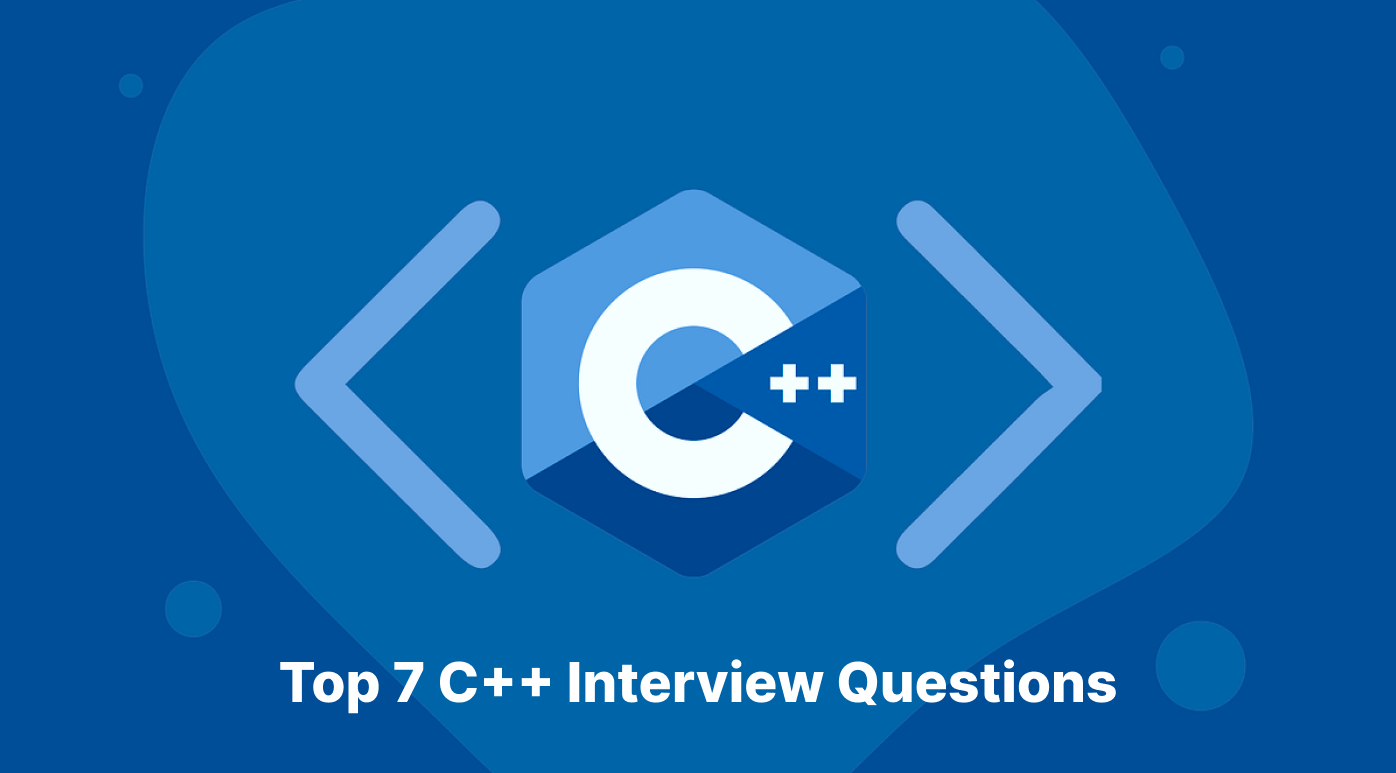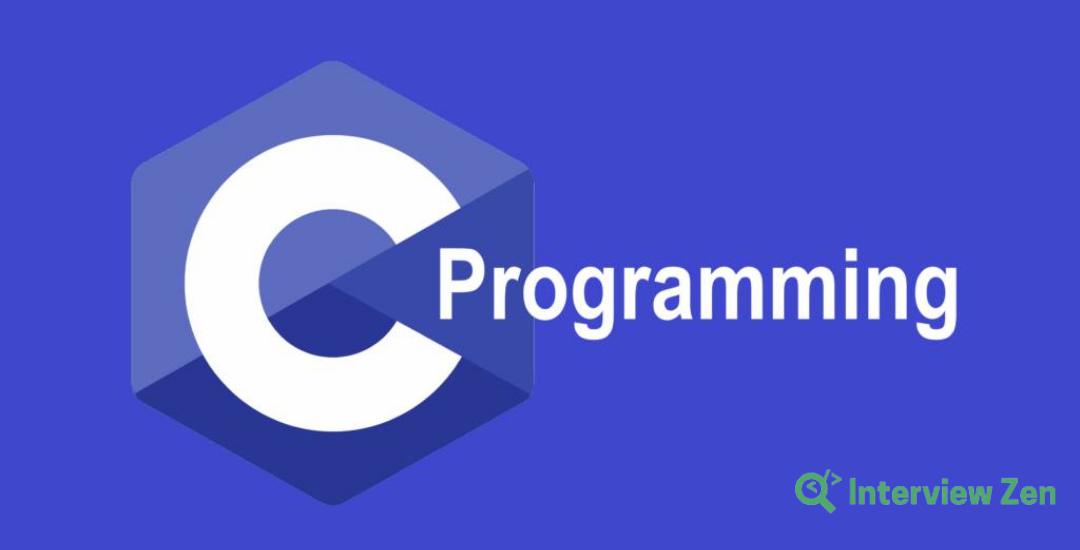Introduction
C++ is a general-purpose programming language often preferred to make high-performance software and is among the top programming languages. Over the past 40 years, C++ has played an important role in software development, powering everything from operating systems and complex game engines to cutting-edge finance, robotics, and beyond applications.
Its unparalleled combination of high-level abstraction and low-level control offers developers the tools to build highly efficient and scalable systems.
According to Statista, C++ ranks as the 9th most-used programming language among developers worldwide in 2024. This statistic highlights the sustained interest and reliance on C++ in the developer community and emphasizes its critical role in the current and future landscapes of software development.

In this article, we will explain the top 7 C++ interview questions designed specifically for hiring managers. These interview questions are crafted to help you assess a candidate’s comprehensive understanding of C++ and their ability to tackle real-world programming challenges.
What is C++?
C++ is a high-level programming language developed by Bjarne Stroustrup at Bell Labs starting in 1979. It was first released in 1985. The development of C++ was motivated by Stroustrup’s desire to create a language that provided high-level features for program organization while retaining the power and efficiency of C.
Originally named C with Classes, it introduced object-oriented features, such as classes and other enhancements to the C programming language.
Over the years, C++ has evolved and includes features like templates, exception handling, namespaces, and a standard template library (STL) which provides a collection of classes and functions for common tasks. It’s widely used for system/software development, game development, drivers, client-server applications, and embedded firmware.
According to the TIOBE Index, C++ is the 3rd most popular programming language with ratings (9.96) in 2024. This statistic shows the language’s enduring relevance and popularity in the global programming landscape, highlighting its critical role in educational and professional contexts.

Key Features
- Object-Oriented Programming (OOP): One of the defining features of C++ is its support for object-oriented programming. This includes concepts like classes, inheritance, polymorphism, and encapsulation, which help in creating complex yet organized software systems.
- Efficiency and Performance: C++ is known for its efficiency in terms of execution speed, making it a preferred choice for software that demands high-performance computing, such as gaming engines, real-time systems, and application development.
- Memory Management: It gives programmers a high degree of control over memory management, which is both a powerful and complex feature. This control allows for the optimization of resources but also requires a deep understanding to avoid issues like memory leaks.
- Standard Template Library (STL): The STL is a powerful set of C++ template classes to provide general-purpose classes and functions with templates that implement many popular and commonly used algorithms and data structures like vectors, lists, queues, and stacks.
- Wide Range of Applications: From system software to application software, graphical user interfaces, and embedded systems, C++ is used in various applications. Its versatility is one of the reasons for its enduring popularity.
- Cross-Platform Development: C++ can be used to develop portable software across multiple platforms. This cross-platform flexibility makes it a desirable language for various development projects.
- Compatibility with C: C++ is almost completely compatible with C, allowing developers to incorporate C code into C++ programs. This backward compatibility ensures that C++ can leverage a vast amount of existing code.
- Community and Resources: Being one of the older programming languages, C++ has a large community of developers. There are many resources available, including libraries, frameworks, and tools, which support the development process.
C++ has evolved significantly over the years, with standards updates (like C++11, C++14, C++17, and C++20) introducing new features and improvements to the language, making it more user-friendly and powerful. It remains one of the most popular programming languages due to its versatility, performance, and the breadth of its application.
Popular companies using C++
- Microsoft: Microsoft extensively uses C++ in its operating systems, including Windows, and in developing several software products like the Microsoft Office suite.
- Google: Google employs C++ for many of its system backends and server applications. It is also used in the development of some parts of the Android operating system and Google Chrome browser.
- Apple: Apple uses C++ in developing its macOS and iOS operating systems and in many of its native applications and frameworks.
- Facebook: Facebook utilizes C++ for several high-performance and high-reliability components within its backend systems, including elements of its messaging and data storage services.
- Amazon: Amazon leverages C++ for high-performance services in its vast e-commerce and cloud computing platforms, including parts of Amazon Web Services (AWS).
- Adobe Systems: Adobe is known for its reliance on C++ in developing numerous creative software products like Photoshop, Illustrator, and After Effects.
- Oracle: Oracle uses C++ for database software and system-level tools. It is particularly used in developing MySQL, one of the world’s most popular database management systems.
- Mozilla: The Mozilla Foundation uses C++ to develop its flagship product, the Mozilla Firefox web browser.
- NVIDIA: NVIDIA utilizes C++ to develop its graphics driver software and CUDA development platform for parallel computing.
- Electronic Arts (EA): EA, one of the leading companies in the gaming industry, uses C++ extensively in game development, particularly for its high-performance and real-time game engines.
Top 7 C++ Interview Questions
Let’s explore the top 7 C++ interview questions:
1. Reversing a String in C++
| Task | Write a function in C++ to reverse a string without using any built-in reverse functions. |
| Input Format | The function should accept a single string argument. |
| Constraints |
|
| Output Format | Return the reversed version of the input string. |
| Sample Input | “Hello World” |
| Output | “dlroW olleH” |
Suggested Answer
| #include <iostream>
#include <string> std::string reverseString(const std::string& str) { std::string reversedStr = str; int length = str.length(); for(int i = 0; i < length / 2; i++) { std::swap(reversedStr[i], reversedStr[length – i – 1]); } return reversedStr; } int main() { std::string input = “Hello World”; std::string output = reverseString(input); std::cout << output << std::endl; return 0; } |
Code Explanation
The reverseString function takes a string str as input. It creates a copy of this string named reversedStr. The function then iterates over half of the string (since swapping is symmetric) and swaps the character at the current index with its corresponding character from the end of the string using std::swap. The reversed string is then returned.
| Common Mistakes to Watch Out For |
|
| Follow-ups |
|
| What the Question Tests | This question assesses the candidate’s understanding of basic string manipulation in C++, their knowledge of loop constructs, and their attention to edge cases in string handling. It also evaluates the candidate’s ability to think about efficiency and optimizations in their code. |
2. Checking for Prime Numbers
| Task | Write a function in C++ to check if a given number is a prime number. A prime number is a natural number greater than 1 that has no positive divisors other than 1 and itself. |
| Input Format | The function should accept a single integer argument. |
| Constraints |
|
| Output Format | Return true if the number is prime and false otherwise. |
| Sample Input | 29 |
| Output | true |
Suggested Answer
| #include <iostream>
bool isPrime(int num) { if (num <= 1) return false; if (num <= 3) return true; if (num % 2 == 0 || num % 3 == 0) return false; for (int i = 5; i * i <= num; i += 6) { if (num % i == 0 || num % (i + 2) == 0) return false; } return true; } int main() { int input = 29; bool output = isPrime(input); std::cout << (output ? “true” : “false”) << std::endl; return 0; } |
Code Explanation
The isPrime function checks if a number is prime. It first handles edge cases (numbers less than 2 and the numbers 2 and 3). For larger numbers, it checks divisibility by 2 and 3.
The loop then checks for factors starting from 5, incrementing by 6 each time (as every prime number other than 2 and 3 is of the form 6k ± 1). The loop runs until i * i is less than or equal to the number, which is an efficient way to check for factors.
| Common Mistakes to Watch Out For |
|
| Follow-ups |
|
| What the Question Tests | This question evaluates the candidate’s ability to implement basic algorithms and their understanding of mathematical concepts. It also tests their efficiency in coding, particularly in optimizing the loop to reduce the number of iterations. It also checks the candidate’s awareness of edge cases and boundary conditions in algorithmic design. |
3. Implementing a Basic Class Structure in C++
| Task | Design and implement a basic Car class in C++. The class should encapsulate the attributes of a car, such as brand, model, and horsepower, and provide methods to set and get these attributes. |
| Input Format | Not applicable as this is a class design and implementation task. |
| Constraints |
|
| Output Format | A well-structured Car class with the specified features. |
| Sample Usage of Class | Car myCar;
myCar.setBrand(“Toyota”); myCar.setModel(“Corolla”); myCar.setHorsepower(132); std::cout << myCar.getBrand() << ” ” << myCar.getModel() << ” – ” << myCar.getHorsepower() << ” HP” << std::endl; |
| Output | Toyota Corolla – 132 HP |
Suggested Answer
| #include <iostream>
#include <string> class Car { private: std::string brand; std::string model; int horsepower; public: void setBrand(const std::string& b) { brand = b; } void setModel(const std::string& m) { model = m; } void setHorsepower(int hp) { horsepower = hp; } std::string getBrand() const { return brand; } std::string getModel() const { return model; } int getHorsepower() const { return horsepower; } }; int main() { // Sample usage as described Car myCar; myCar.setBrand(“Toyota”); myCar.setModel(“Corolla”); myCar.setHorsepower(132); std::cout << myCar.getBrand() << ” ” << myCar.getModel() << ” – ” << myCar.getHorsepower() << ” HP” << std::endl; return 0; } |
Code Explanation
The Car class is designed with three private attributes: brand, model, and horsepower. It includes setter methods (setBrand, setModel, setHorsepower) to assign values to these attributes and getter methods (getBrand, getModel, getHorsepower) to retrieve their values.
This design follows the principles of encapsulation, ensuring that the class’s internal state cannot be directly altered from outside the class.
| Common Mistakes to Watch Out For |
|
| Follow-ups |
|
| What the Question Tests | This question assesses a candidate’s understanding of basic object-oriented programming principles in C++, particularly class design, encapsulation, and data hiding. It also evaluates their ability to write clean, organized, and maintainable code. |
4. Implementing a Simple Linked List in C++
| Task | Write a C++ program to implement a basic singly linked list. The program should include functions to add a new node to the end of the list and to display the entire list. |
| Input Format |
|
| Constraints |
|
| Output Format |
|
| Sample input and Usage | LinkedList myList;
myList.addNode(5); myList.addNode(10); myList.displayList(); // Should display: 5 -> 10 |
| Output | 5 -> 10 |
Suggested Answer
| #include <iostream>
class Node { public: int data; Node* next; Node(int val) : data(val), next(nullptr) {} }; class LinkedList { private: Node* head; public: LinkedList() : head(nullptr) {} void addNode(int value) { Node* newNode = new Node(value); if (head == nullptr) { head = newNode; } else { Node* temp = head; while (temp->next != nullptr) { temp = temp->next; } temp->next = newNode; } } void displayList() { Node* temp = head; while (temp != nullptr) { std::cout << temp->data << ” -> “; temp = temp->next; } if (head != nullptr) { std::cout << “NULL” << std::endl; } } ~LinkedList() { while (head != nullptr) { Node* temp = head; head = head->next; delete temp; } } }; int main() { // Sample usage as described LinkedList myList; myList.addNode(5); myList.addNode(10); myList.displayList(); return 0; } |
Code Explanation
The program defines two classes: Node and LinkedList. Node represents each element in the list, holding an integer data and a pointer next to the next node. LinkedList manages the nodes, with addNode to add new elements and displayList to print all the elements. The destructor ~LinkedList, properly deallocates memory to prevent memory leaks.
| Common Mistakes to Watch Out For |
|
| Follow-ups |
|
| What the Question Tests | This question tests the candidate’s understanding of basic data structures, particularly linked lists, in C++. It assesses their ability to manage memory, implement class methods, and handle pointers correctly. It also evaluates their understanding of dynamic memory allocation and deletion, which is crucial in C++ programming. |
5. Handling File Operations in C++
| Task | Write a C++ program to read a text file and count the number of words in the file. Assume standard English words separated by spaces, punctuation, or newlines. |
| Input Format | The program should take the file path as an input. |
| Constraints |
|
| Output Format | The program should output the total count of words in the file. |
| Sample input | FilePath: “example.txt” |
| Output | Number of words in file: 150 |
Suggested Answer
| #include <iostream>
#include <fstream> #include <string> int countWordsInFile(const std::string& filePath) { std::ifstream file(filePath); if (!file.is_open()) { std::cerr << “Error opening file” << std::endl; return -1; } int wordCount = 0; std::string word; while (file >> word) { wordCount++; } file.close(); return wordCount; } int main() { std::string filePath = “example.txt”; int wordCount = countWordsInFile(filePath); std::cout << “Number of words in file: ” << wordCount << std::endl; return 0; } |
Code Explanation
The program includes the countWordsInFile function, which takes a file path as input and counts the number of words. It uses the <fstream> library to open and read the file. The std::ifstream object (file) reads words from the file using the extraction operator (>>), which automatically considers spaces, newlines, and punctuation as delimiters.
The function counts each word it reads and returns the total count. Error handling is included to manage cases where the file cannot be opened.
| Common Mistakes to Watch Out For |
|
| Follow-ups |
|
| What the Question Tests | This question evaluates the candidate’s ability to perform file operations in C++, including opening, reading, and closing files. It also tests their understanding of basic string processing and word counting logic in C++. The task requires attention to detail in handling different word delimiters and robust error handling for file operations. |
6. Implementing a Basic Sorting Algorithm in C++
| Task | Write a C++ program to implement a sorting algorithm (like bubble sort or selection sort) to sort an array of integers in ascending order. |
| Input Format | The program should take an array of integers as input. |
| Constraints |
|
| Output Format | The program should output the sorted array. |
| Sample input | Array: [34, 12, 5, 66, 1] |
| Output | [1, 5, 12, 34, 66] |
Suggested Answer
| #include <iostream>
#include <vector> void bubbleSort(std::vector<int>& arr) { int n = arr.size(); for (int i = 0; i < n – 1; i++) { for (int j = 0; j < n – i – 1; j++) { if (arr[j] > arr[j + 1]) { std::swap(arr[j], arr[j + 1]); } } } } int main() { std::vector<int> input = {34, 12, 5, 66, 1}; bubbleSort(input); for (int i : input) { std::cout << i << ” “; } std::cout << std::endl; return 0; } |
Code Explanation
The program includes the bubbleSort function, which uses the bubble sort algorithm to sort an array. The function iterates over the array, repeatedly swapping adjacent elements if they are in the wrong order.
This process is repeated until the array is sorted. The std::swap function is used for swapping elements. The function operates in-place, modifying the original array.
| Common Mistakes to Watch Out For |
|
| Follow-ups |
|
| What the Question Tests | This question assesses the candidate’s understanding of basic sorting algorithms and their implementation in C++. It tests their knowledge of array manipulation, nested loops, and the efficiency of their code. The ability to implement and understand simple algorithms like bubble sort is fundamental in computer science and programming. |
7. Creating a Simple Memory Allocation Tracker in C++
| Task | Write a C++ program to create a simple memory allocation tracker. The program should override the new and delete operators to keep track of the total memory allocated and deallocated during the program’s runtime. |
| Input Format | General use of new and delete in the program for dynamic memory allocation. |
| Constraints |
|
| Output Format | The program should output the total memory allocated and deallocated before the program terminates. |
| Sample input | General use within the program (e.g., allocating and deallocating integers, arrays). |
| Output | Total memory allocated: X bytes
Total memory deallocated: Y bytes |
Suggested Answer
| #include <iostream>
#include <cstddef> std::size_t totalAllocated = 0; std::size_t totalDeallocated = 0; void* operator new(std::size_t size) { totalAllocated += size; return malloc(size); } void operator delete(void* memory, std::size_t size) noexcept { totalDeallocated += size; free(memory); } int main() { int* num = new int(5); delete num; int* array = new int[10]; delete[] array; std::cout << “Total memory allocated: ” << totalAllocated << ” bytes” << std::endl; std::cout << “Total memory deallocated: ” << totalDeallocated << ” bytes” << std::endl; return 0; } |
Code Explanation
The program overrides the global new and delete operators. The new operator is overridden to add the size of the allocated memory to totalAllocated and then allocate the memory using malloc.
The delete operator is overridden to add the size of the deallocated memory to totalDeallocated and then free the memory using free. This allows tracking the total amount of memory allocated and deallocated during the program’s execution.
| Common Mistakes to Watch Out For |
|
| Follow-ups |
|
| What the Question Tests | This question evaluates the candidate’s understanding of dynamic memory management in C++, particularly the use of new and delete operators. It tests their ability to implement custom functionality around built-in operations and their understanding of memory allocation and deallocation. This task also touches on advanced C++ concepts, such as operator overloading and memory management, which are crucial for writing efficient and robust C++ applications. |
Conclusion
In conclusion, hiring skilled C++ software engineers requires a thoughtful approach to interviewing, an emphasis on comprehensive skills assessment, and the effective use of technological tools.
Creating effective C++ interview questions involves a deep understanding of the language’s capabilities, practical applications, and the specific requirements of the role. The ability to design interview questions that test technical knowledge, problem-solving skills, coding efficiency, and adaptability is crucial in identifying the best candidates for software development roles.
Interview Zen offers a clear path forward for hiring managers seeking to refine their C++ interviewing process. The platform’s capabilities align perfectly with the needs of a technical interview, providing a structured and effective way to evaluate candidates.
We encourage hiring managers to embrace Interview Zen for their C++ interview needs. Whether you are looking to streamline your interview process, enhance the quality of your technical assessments, or ensure a fair and unbiased evaluation, Interview Zen stands as a powerful ally.
Don’t miss the opportunity to elevate your hiring practice to the next level. Try Interview Zen for your next round of technical interviews.
Read more articles:



